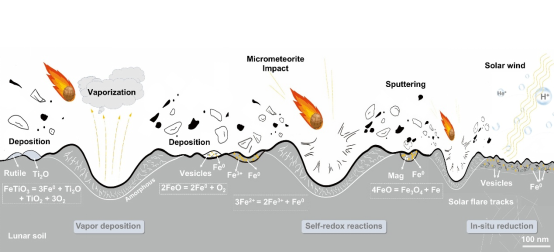
Lunar surface weathering processes are essential for understanding the evolution of airless planetary bodies. Previous theories suggest that micrometeorite impacts and solar wind irradiation primarily drive lunar space weathering, leading to nanophase metallic iron (np-Fe⁰) and spectral reddening. However, recent data from the Chang'e-5 and Chang'e-6 missions, along with remote-sensing observations, have uncovered impact-generated magnetite, disproportionation reactions, and oxidation signatures possibly linked to Earth's magnetotail. These findings suggest that current models inadequately depict the oxidation-reduction pathways in lunar weathering.
To tackle this challenge, a collaborative research team from the Institute of Geochemistry of the Chinese Academy of Sciences (IGCAS), Sun Yat-sen University, Yunnan University, and Guilin University of Technology has employed multi-scale analytical techniques—including transmission electron microscopy (TEM), electron energy loss spectroscopy (EELS), and electron spin resonance (ESR)—to systematically analyze regolith samples from Chang'e-5 (near side) and Chang'e-6 (far side). Their findings were published in Particuology.
The researchers constructed a multi-scale dynamic framework that includes "vapor deposition-driven open reductive reactions," "in situ reduction reactions," and "self-redox reactions." For instance, vapor-deposited layers found on pyroxene grains from Chang'e-6 contain np-Fe⁰ particles and vesicular structures, providing evidence of high-temperature vapor condensation caused by micrometeorite impacts.
Additionally, iron whiskers and porous textures in Chang'e-5 sulfide grains indicate sulfur loss and in situ reduction, driven by the combined effects of impact events and solar wind irradiation.
This study broadens our understanding of lunar redox processes, moving from a singular mechanism to a dynamically multi-driven system. It revises the oversimplified "purely reducing environment" concept from the Apollo era. The new framework not only offers a theoretical basis for interpreting lunar spectral evolution and changes in mineral assemblages but also establishes a universal paradigm for studying space weathering on airless bodies like Mercury and asteroids.
Comparisons between the far-side Chang'e-6 samples (from the South Pole-Aitken Basin, approximately 2.8 billion years old) and the near-side Chang'e-5 samples (with Is/FeO ratios of 66 ± 3.2 and 65 ± 10, respectively) provide critical data for understanding the spatiotemporal heterogeneity of lunar surface evolution.

Schematic diagram of redox dynamics at multiple scales on the lunar surface, including vapor deposition-driven open reductive reactions, in-situ reduction reactions, and self-redox reactions.(Image by IGCAS)

86-10-68597521 (day)
86-10-68597289 (night)

52 Sanlihe Rd., Xicheng District,
Beijing, China (100864)

